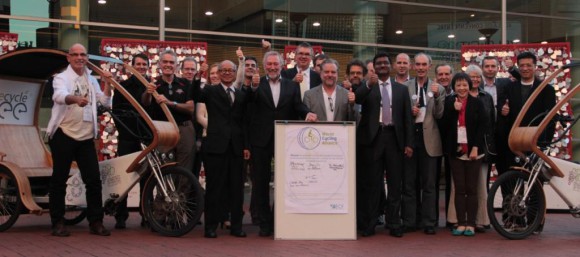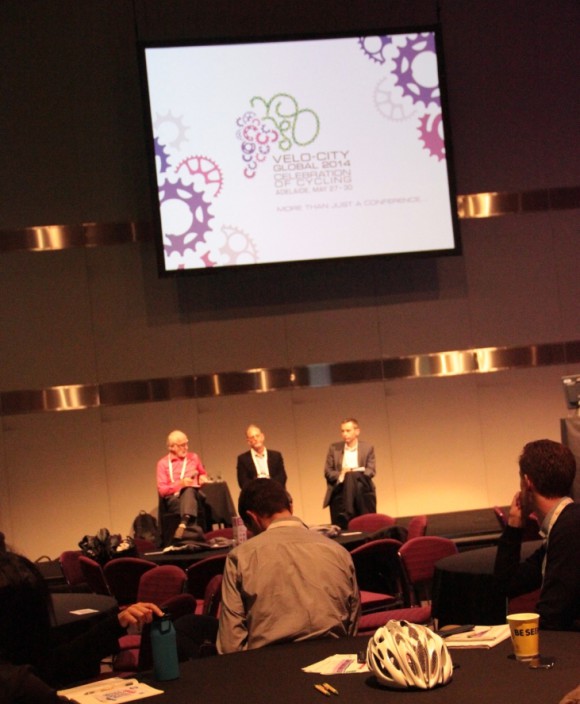
Velo-city Roundup Day 3 - World stage, helmets and San Francisco
After a third colorfull day @Velo-city, it is time to prepare for the official sessions in the classy Town Hall on Friday. Whether you were there or not, you can get a bite of advocacy and policy discussions through the fantastic summaries below. Remember, you can follow the live course of the conference on our dedicated news page, on twitter #vcg14 and if you are more a visual kind of person, on our flickr album.
- Official launch of the World Cycling Alliance
- Velo-city session on helmets – Lifting the lid on Australia’s helmet laws
- All The 2 -Wheels Souls Welcome You To San Francisco
- Miscellaneous
Official launch of the World Cycling Alliance
The voices of more than a million cyclists from six continents and over 80 countries were united today when the World Cycling Alliance was launched at Velo-city Adelaide.
This new network is specifically aimed at influencing major world institutions such as the United Nations, the World Bank and the World Health Organisation, promoting the role cycling can play in addressing the challenges of global sustainability. WCA will also support the worldwide exchange of knowledge, expertise and co-operation of cycling associations and organizations.
ECF President Manfred Neun said “I am excited and encouraged by the reaction of our cycling colleagues around the globe to the launch of the World Cycling Alliance. I want to thank all those who have supported us in getting to this global launch today, this is a uniting moment for our communities. Together we are stronger.”
Velo-city session on helmets – Lifting the lid on Australia’s helmet laws
The helmets session at Velo-city was an interesting session with three different looks at the current Mandatory Helmet Law in Australia, the effects on advocacy, cycling numbers and safety.
Michael Bridge from Bicycle SA kicked off with an interesting look at how advocacy groups can deal with the mandatory helmet situation in Australia. He said that perhaps we should stop worrying about what everyone else does outside of Australia and worry on how Australians can make cycling better and safer. He thought that if all the oxygen that was used up on the helmet debate were redirected towards better infrastructure and safety interventions then better progress could be made. Better statistics and data were needed before definite conclusions were reached concerning repealing helmet legislation. It was, Michael said, difficult to offer comfort to those that did not want to wear a helmet, but in the meantime perhaps Australians can be inspired by cyclists that celebrate the use of the helmet. Instead of complaining about what we don’t want we could embrace what we do have.
Chris Rissel from the University of Sydney took a more data and evidence driven look at the figures to see how Mandatory Helmet Law (MHL) actually worked in the country. Firstly he looked at the risks associated with cycling and stressed that there was not any particularly greater risk for Australians cycling than with any other around the world with the benefits always outweighing the risk. Interestingly he showed the lack of evidence at the population level concerning the efficacy of bicycle helmets to reduce head injuries. The reduction in head injuries after the helmet legislation in 1991 followed the same trajectory as pedestrian and motor vehicle occupant injuries, suggesting that helmets had little effect in injury reduction. What was also important for Chris was the effect on cycling numbers. The numbers of cyclists fell drastically after the legislation and has never really recovered.
Ian Kerr from CATALYST (Consulting in Applied Transport Access & Land Use Systems) was next to speak. He was concerned about the creep into policy fields of ideology and saw this as a particular problem with MHLs. He agreed with Michael that helmet legislation and policy distracts resources from other more beneficial road safety interventions, however in his opinion this was a situation that needed rectifying. In fact if MHL does indeed reduce the numbers of cyclists then this also has an effect on cycling safety by reducing or reversing the Safety in Numbers principle counter intuitively making cycling more dangerous for the remaining cyclists. Ian thought that another of the major problems of looking into MHL is the over reliance by policy makers on the intrinsic effects of helmets without taking into account the extrinsic and broader social effects; the risk compensation; safety in numbers; barriers to cycling; the health cost/benefit. He put forward figures showing that the numbers of cyclists lost to MHL has not yet recovered more than twenty years later, and which has also changed the cycling culture in Australia with cycling tending to be represented by sports and leisure cycling rather than everyday mass cycling. He calculated that around 70% of all the different benefits that cycling brings has been lost by the imposition of a ban on cycling without helmets.
All The 2 -Wheels Souls Welcome You To San Francisco
 photo by @BicycleNSW
photo by @BicycleNSW
Timothy Papandreou is the Director for Transportation in the San Francisco metropolitan area. Today he gave us some insights on the development of cycling in the Californian city.
SF is set to grow over next years and decades while public transport is already running at full capacity thus the only way to cater for extra demand is by increasing walking and cycling mode shares.
The current cycling mode share (2011) is 3.5%. The objective is to reach 9% in 2018 with a decrease of car modal share to 50% at the same time.
The integrated transport strategy includes all modes of transport, taxi, parking, goods delivery . A complementary Bicycle Plan has been developed and adopted with 3 tiers: infrastructure, support facilities and communication and marketing.
Thanks to the local advocacy groups, urban development is done using the “complete streets approach” (using the NACTO Urban Street Design Guide as basis) which was developed about 10 years ago and not contested anymore by any political party.
Also the parking demand management is an important part of Transport Strategy: 25` % of congestion is caused by drivers searching for car parking.
And Tim concluded by asking the audience to be optimistic for their own cities “It can be done. It’s being done. If SF can do, you can do it as well.”
Miscellaneous
Place-to-be of the day
 Photo by @christodemp
Photo by @christodemp
Adelaide Riverbank cycle path on Sunset, just magic!
App of the day
Counterpointapp.org . Just grab a coffee and sit on your favourite bench. You can start counting traffic.
- Log in to post comments
Contact the author
Recent news!
Upcoming events
Contact Us
Avenue des Arts, 7-8
Postal address: Rue de la Charité, 22
1210 Brussels, Belgium












